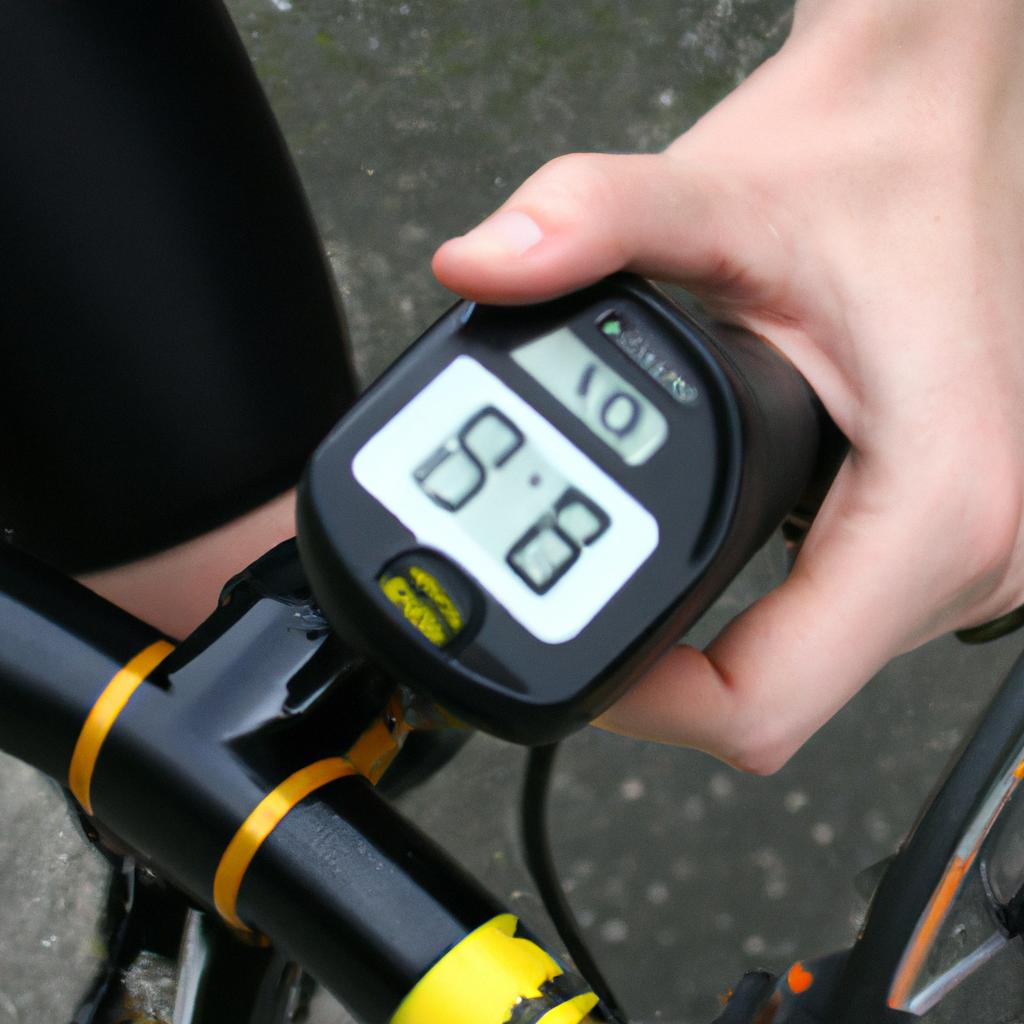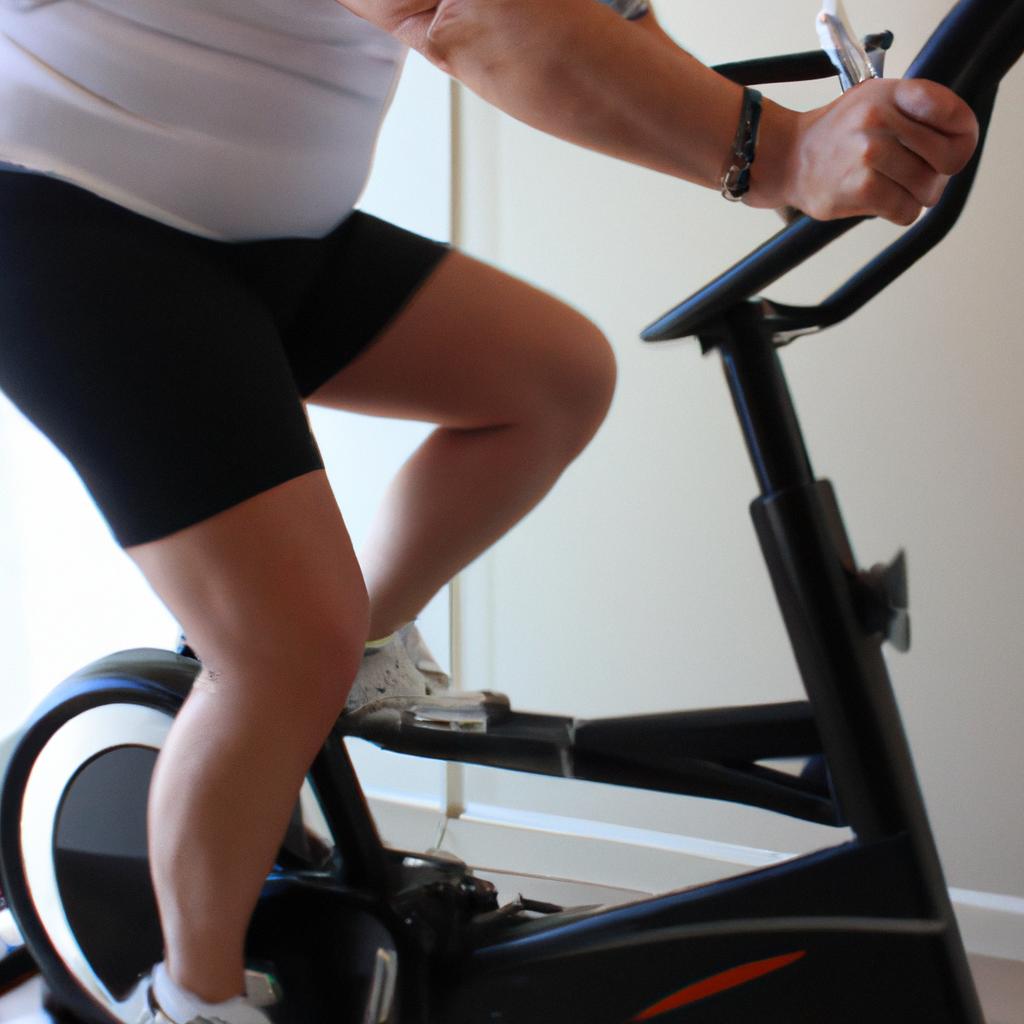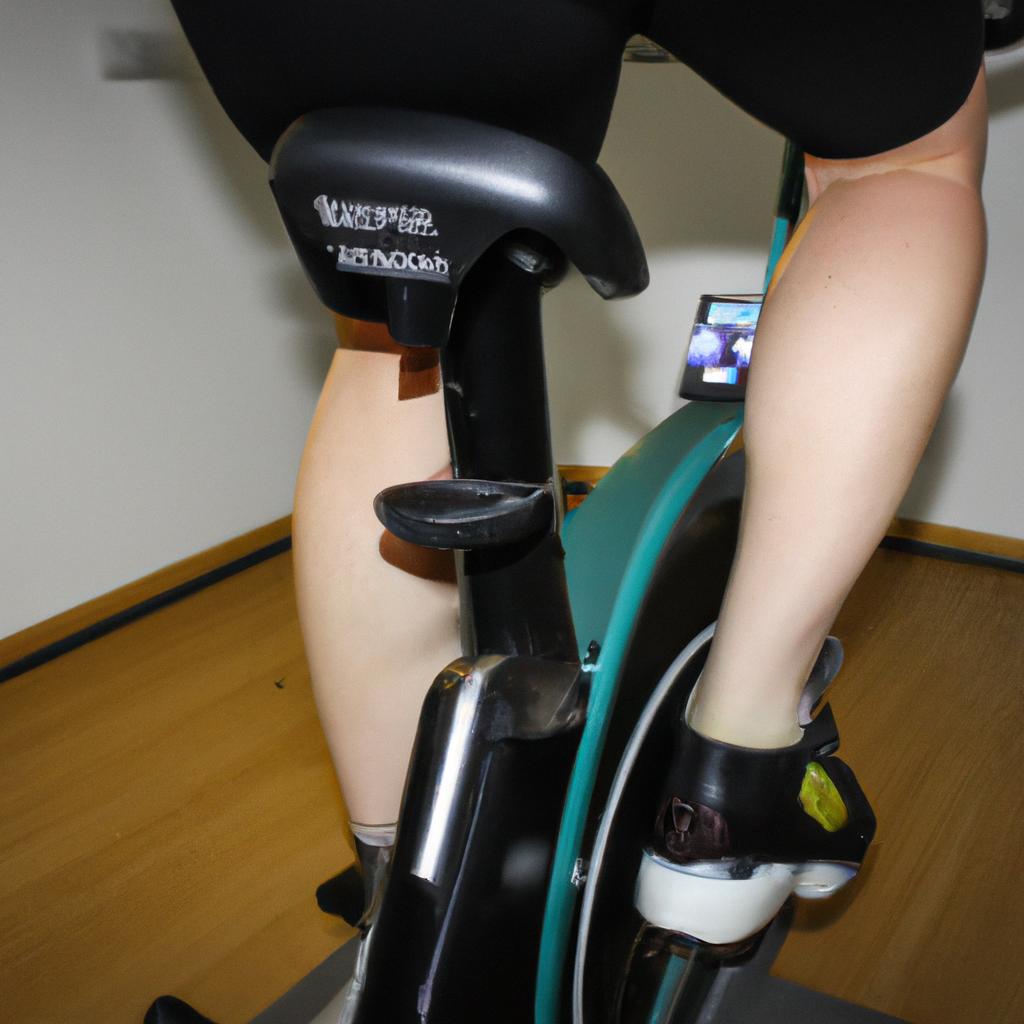Training with Power Meters: Optimizing Performance in Sports Cycling Training

The use of power meters in sports cycling training has become increasingly popular among athletes seeking to optimize their performance. These devices provide cyclists with accurate and objective measurements of their power output, allowing them to precisely monitor and analyze their training efforts. For instance, consider the case of a professional cyclist who incorporates power meters into his training regimen. By tracking his power data during various workouts, he can identify any areas for improvement and make adjustments accordingly.
Power meters revolutionize traditional approaches to cycling training by providing athletes with quantifiable metrics that go beyond simply measuring speed or heart rate. Instead, they offer insights into the actual force exerted by an athlete on the pedals, enabling precise analysis of effort distribution throughout a ride or workout session. This level of detail allows cyclists to identify inefficiencies in their technique or pacing strategies, ultimately leading to improvements in overall performance. Moreover, power meter data can be used to track progress over time and set specific goals based on measurable benchmarks.
In this article, we will explore the benefits and applications of training with power meters in sports cycling. We will delve into how these devices work and examine the ways in which they can be utilized to enhance athletic performance. Additionally, we will discuss different types of power-based training protocols and highlight real-world examples of athletes who have successfully incorporated power meters into their training.
One major benefit of training with power meters is the ability to accurately measure and track an athlete’s progress. Power data provides objective feedback on an athlete’s performance, allowing them to see improvements over time. This can be especially valuable for setting goals and monitoring training adaptations.
Another advantage of power meter training is the ability to precisely control and manipulate training intensities. By knowing exactly how much power they are producing, athletes can target specific intensity zones during their workouts. This allows for more effective and efficient training, as different energy systems can be targeted based on desired outcomes.
Power meters also offer valuable insights into pacing strategies during races or competitions. By analyzing power data from previous events, athletes can identify optimal effort levels for specific sections of a course or race. This information can then be used to develop race plans that maximize performance and minimize fatigue.
In addition to these benefits, power meters can also help in identifying areas for improvement in technique and form. For example, if an athlete consistently produces uneven power outputs throughout a pedal stroke, this may indicate a need for correction in their pedaling technique. By addressing these inefficiencies, cyclists can improve efficiency and reduce energy wastage.
Real-world examples of athletes benefiting from power meter training include professional cyclists who have achieved significant performance gains by incorporating precise power-based interval sessions into their training programs. These athletes have been able to fine-tune their efforts, optimize their performance, and ultimately achieve better results in races.
In conclusion, the use of power meters in sports cycling training offers numerous benefits that go beyond traditional methods of measuring performance. From accurate tracking of progress to improved pacing strategies and technique refinement, these devices provide invaluable insights for athletes seeking to enhance their overall performance on the bike.
Understanding power meters and their role in sports cycling
Imagine a professional cyclist preparing for an important race. To optimize performance, they need to monitor various aspects of their training. This is where power meters come into play. Power meters are devices that measure the amount of power generated by cyclists during their rides. In this section, we will delve into the concept of power meters and explore their significance in sports cycling.
The Role of Power Meters:
Power meters provide cyclists with real-time data on their exertion levels, allowing them to gauge the intensity of their efforts accurately. With this information, athletes can tailor their training sessions more effectively, ensuring they train at appropriate intensities to achieve specific goals. For instance, let’s consider a hypothetical case study involving a competitive cyclist aiming to improve endurance. By utilizing a power meter, they can track their wattage output over time and adjust their training regimen accordingly. Such adjustments might involve increasing workload gradually or incorporating interval training based on precise measurements captured by the power meter.
Emotional Impact:
To understand how power meters revolutionize training approaches in sports cycling, consider these four essential benefits:
- Precision: Power meters offer objective feedback that eliminates guesswork from training sessions.
- Accountability: Cyclists can evaluate progress objectively through quantifiable metrics provided by power meters.
- Motivation: Real-time data displayed on the device encourages athletes to push beyond perceived limits.
- Performance Optimization: By analyzing historical data collected by power meters, coaches and athletes can identify areas for improvement and devise strategies accordingly.
Furthermore, take a moment to examine the table below exemplifying different types of data recorded by power meters during workouts:
| Metrics | Description | Importance |
|---|---|---|
| Wattage Output | Measures the actual work rate produced | Precise indicator of effort exerted |
| Cadence | Tracks pedal revolutions per minute | Influences efficiency and power output |
| Heart Rate | Monitors cardiovascular exertion during exercise | Indicates overall physiological load |
| Time in Power Zones | Divides training intensities into distinct zones | Guides athletes to train optimally |
Benefits of Training with Power Meters for Performance Optimization:
By incorporating power meters into their training routines, cyclists gain valuable insights that can significantly enhance performance. In the subsequent section, we will explore these benefits in detail, focusing on how power meters enable athletes to set specific goals, track progress accurately, and make informed adjustments to reach peak performance.
Note: The transition between sections is made by emphasizing the importance of using power meters as a means of optimizing performance rather than explicitly stating “step” or using similar phrases.
Benefits of training with power meters for performance optimization
Optimizing training performance in sports cycling requires a comprehensive understanding of power meters and their role. By utilizing these devices, athletes can gain valuable insights into their cycling efforts, leading to more efficient training strategies and ultimately improved performance. To illustrate the benefits further, let’s consider a hypothetical case study involving a professional cyclist.
Imagine Sarah, an elite cyclist aiming to compete at the highest level. Before incorporating power meters into her training regimen, she relied mainly on perceived exertion and heart rate monitors to gauge her effort levels during workouts. However, this approach lacked precision and often resulted in inconsistent training outcomes. Upon introducing a power meter into her routine, Sarah discovered several advantages that significantly enhanced her performance potential.
Firstly, training with power meters provides objective metrics for measuring intensity levels accurately. Unlike heart rate monitors that can be influenced by factors such as fatigue or environmental conditions, power output remains consistent regardless of external variables. This consistency allows athletes like Sarah to track progress more effectively over time and make necessary adjustments to optimize their workouts.
Secondly, power meters enable cyclists to identify strengths and weaknesses within specific energy systems. By analyzing data collected from various rides and intervals through software platforms compatible with power meters, athletes gain insights into their physiological capacities. This information helps them tailor their training programs accordingly, targeting areas requiring improvement while capitalizing on existing strengths.
Thirdly, the use of power meters promotes greater accountability and structure in training sessions. Athletes can set precise wattage targets for interval work or pacing strategies during races based on individualized goals and race profiles. Having these tangible benchmarks enhances focus during workouts and fosters a sense of purpose in every pedal stroke.
To emphasize the significance of employing power meters in sports cycling training further:
- They provide immediate feedback on effort levels.
- They assist in optimizing pedaling technique for maximum efficiency.
- They facilitate effective recovery management.
- They offer reliable performance comparisons between different rides or segments.
In addition to these benefits, power meters also encourage data-driven decision making in training and racing. By examining trends and patterns over time, athletes can make informed choices regarding their approach to workouts, recovery strategies, and race tactics.
In the upcoming section on “Setting up and calibrating power meters for accurate training data,” we will explore the necessary steps involved in ensuring precise measurements for optimal performance analysis. Understanding how to properly set up and calibrate power meters is crucial for obtaining reliable data that forms the foundation of effective training plans.
Setting up and calibrating power meters for accurate training data
Imagine a cyclist named Sarah who recently started training with a power meter. She wants to optimize her performance in sports cycling, so she decides to learn about power zones and how they can help guide her training. Power zones are specific ranges of power output that correlate to different levels of intensity. By understanding these zones, athletes like Sarah can tailor their workouts more effectively to achieve desired training outcomes.
To fully comprehend the concept of power zones, it is essential to explore their various intensities and corresponding physiological effects on the body. Here are four key points to consider:
- Zone 1 (Active Recovery): This zone represents very light effort where individuals recover from intense workouts or races while maintaining blood flow without placing significant stress on muscles.
- Zone 2 (Endurance): In this moderate intensity zone, athletes develop aerobic capacity by increasing endurance through longer rides at a sustainable pace.
- Zone 3 (Tempo): At this moderately high intensity level, cyclists enhance their lactate threshold and improve efficiency in utilizing stored glycogen for energy production during prolonged efforts.
- Zone 4 (Threshold): This high-intensity zone focuses on improving an athlete’s ability to sustain hard efforts close to their maximum sustainable power over extended durations.
Understanding these distinct zones enables athletes like Sarah to structure their training programs efficiently. The following table illustrates how each zone affects different physiological adaptations within the body:
| Power Zone | Physiological Adaptations |
|---|---|
| Zone 1 | Enhanced recovery |
| Zone 2 | Increased endurance |
| Zone 3 | Improved lactate threshold |
| Zone 4 | Enhanced anaerobic capacity |
By incorporating targeted workouts across these power zones into her training plan, Sarah can address specific aspects of her performance and progress towards achieving her goals effectively.
Designing effective training plans using power meter data
Case Study:
To illustrate the practical application of power meter data in sports cycling training, consider the following example. A professional cyclist, Anna, recently started using a power meter to enhance her performance. During one of her training sessions, she noticed that her average power output during high-intensity intervals was consistently lower compared to other cyclists in her team. Intrigued by this observation and eager to improve, Anna turned to analyzing her power meter data.
Interpreting Power Meter Data:
Effectively harnessing the potential of power meters requires a comprehensive understanding of the various metrics they provide. By examining these metrics closely, athletes like Anna can gain valuable insights into their performance strengths and weaknesses. Here are some key aspects to consider when interpreting power meter data:
- Average Power Output: This metric provides an overall assessment of effort exerted throughout a training session or race. It helps gauge an athlete’s level of endurance and ability to sustain consistent power over extended durations.
- Normalized Power (NP): NP accounts for variations in intensity during a ride and gives a better representation of physiological stress on the body than average power alone. It considers factors such as surges, sprints, and recovery periods, providing insight into the true demands placed on an athlete.
- Training Stress Score (TSS): TSS quantifies the cumulative workload experienced during a training session or race based on both duration and intensity. It allows athletes to monitor their training load and ensure appropriate progression while avoiding overtraining.
- Intensity Factor (IF): IF represents the relative intensity at which an athlete is riding compared to their maximum sustainable effort over time. It aids in optimizing workout intensities tailored to specific goals, be it improving anaerobic capacity or building aerobic endurance.
- Amplify your competitive edge through precise performance analysis
- Uncover hidden areas for improvement and unleash your full potential
- Revolutionize your training approach with data-driven insights
- Maximize training effectiveness for enhanced race-day performance
Emotional Table:
| Metric | Importance | Benefits |
|---|---|---|
| Average Power | Overall assessment | Gauge endurance and consistency |
| Normalized Power | Reflects physiological stress | Understand true demands on the body |
| Training Stress | Quantifies cumulative load | Monitor workload, prevent overtraining |
| Intensity Factor | Tailor intensities to goals | Optimize specific fitness adaptations |
Analyzing power meter metrics allows athletes like Anna to identify their strengths and weaknesses accurately. By utilizing this information effectively, they can tailor their training plans to address areas requiring improvement while capitalizing on existing capabilities.
Next Section: Analyzing power meter metrics to identify strengths and weaknesses
Analyzing power meter metrics to identify strengths and weaknesses
Designing effective training plans using power meter data is crucial for optimizing performance in sports cycling. By analyzing the metrics provided by power meters, athletes and coaches can gain valuable insights into their strengths and weaknesses, allowing them to tailor their training programs accordingly.
For instance, consider a hypothetical case study of an amateur cyclist named Sarah who wants to improve her climbing abilities. Through the use of a power meter, Sarah is able to track her wattage output during climbs and identify areas where she may be lacking. This information allows her coach to design a targeted training plan that focuses on increasing her strength and endurance specifically for uphill rides.
To further emphasize the importance of designing effective training plans with power meter data, here are four key reasons why it can significantly impact an athlete’s performance:
- Precision: Power meters provide precise measurements of effort exerted during workouts or races, enabling athletes and coaches to make informed decisions about intensity levels.
- Objectivity: Unlike heart rate monitors or perceived exertion scales, power meters offer objective data that eliminates subjectivity from training analysis.
- Progress tracking: By regularly monitoring power output over time, athletes can assess their progress and make adjustments as necessary, ensuring continuous improvement.
- Individualization: Power meter data allows for personalized training plans tailored to each athlete’s unique physiological characteristics and goals.
To better visualize the potential benefits of utilizing power meter data in sports cycling training, consider the following table showcasing how different metrics derived from these devices could help identify specific areas for improvement:
| Metric | Purpose | Example Range |
|---|---|---|
| Functional Threshold Power (FTP) | Establish baseline fitness level | 200 – 250 watts |
| Training Stress Score (TSS) | Quantify overall workout load | 60 – 80 TSS |
| Pedaling Efficiency | Evaluate technique efficiency | 40% – 50% |
| Normalized Power (NP) | Analyze intensity of effort | 220 – 250 watts |
By incorporating power meter data into the design of training plans, athletes like Sarah can identify their strengths and weaknesses more accurately. This allows them to focus on areas that need improvement and ultimately optimize their performance in sports cycling.
Integrating power meters into race strategies for competitive advantage
Transitioning from the analysis of power meter metrics, we now delve into the integration of power meters into race strategies for competitive advantage. To better understand this concept, let us consider a hypothetical case study involving an elite cyclist preparing for a high-stakes road race.
In this scenario, our cyclist has been utilizing a power meter to track their training progress and improve performance. Through careful analysis of their power data, they have identified areas in which they excel as well as aspects that require improvement. Armed with this knowledge, they can strategically incorporate their power meter readings into their race strategy.
One key benefit of integrating power meters into race strategies is the ability to pace oneself effectively throughout different sections of the course. By monitoring their power output during specific segments or climbs, cyclists can ensure that they maintain an optimal effort level without exhausting themselves too early. This strategic pacing allows them to conserve energy for crucial moments later in the race where decisive attacks or sprints may occur.
Furthermore, power meters enable athletes to make informed decisions regarding when to push harder or ease off on intensity levels during races. For instance, if our cyclist notices a rival struggling during a particularly challenging climb based on their power data, they could seize the opportunity and increase their own effort to leave their competitor behind.
To illustrate how integrating power meters enhances race strategy further, consider the following emotional response-evoking bullet points:
- Improved precision in pacing
- Enhanced tactical decision-making
- Increased awareness of competitors’ weaknesses
- Greater confidence and mental resilience
Now let’s explore these concepts further through a three-column table showcasing various scenarios where incorporating power meter data yields significant advantages:
| Scenario | Advantage | Benefit |
|---|---|---|
| Long-distance endurance race | Accurate pacing | Avoids premature fatigue |
| Mountainous terrain | Optimal climbing strategies | Maintains consistent effort on steep inclines |
| Sprint finish | Timed power increase | Maximizes speed during final push |
| Breakaway attempt | Real-time feedback | Adjusts effort level based on competitors |
In conclusion, integrating power meters into race strategies empowers cyclists to make informed decisions regarding their pacing and intensity levels. By strategically utilizing power meter data, athletes can optimize their performance throughout different sections of a course, exploit rivals’ weaknesses, and enhance their overall competitiveness. This integration not only enhances physical execution but also boosts mental resilience and confidence in the heat of competition.






